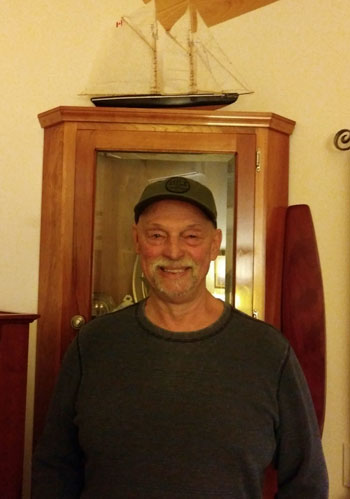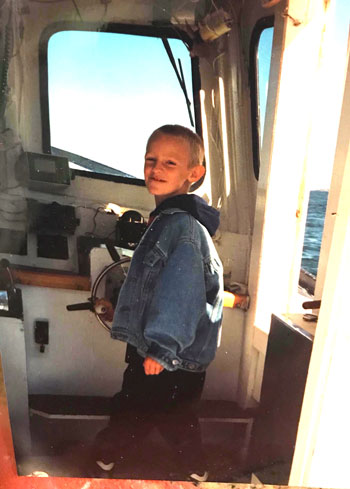Scallop Lottery Gives Four Winners a ‘Golden Opportunity’
Continued from Homepage

Fitzsimmons, seen here with girlfriend Kendra Anthony and their son Carter, fishes in Lubec and comes from a long line of fishermen on both sides of his family. He won one of two licenses in the 18-30 age group. Photo courtesy Chase Fitzsimmons.
trajectory. The 2008 scallop landings were 665,000 pounds and the fishery’s value came in below $600,000. Preliminary 2017 data show landings over 6.6 million pounds and a fishery value exceeding $9 million.
The reversal of fortune is attributable to a series of conservation measures the DMR initiated in 2012. The new system divides the coast into large zones and smaller areas that are opened and shut according to a calendar and the health of the resource, continually assessed throughout the season. These intervals allow the scallop population time to recover between cycles of harvesting.
Lottery winner Chase Fitzsimmons of Lubec also comes from a long line of fishermen, including his father who holds a scallop license and fishes for urchins, too. When Fitzsimmons entered the lottery he never thought he had a chance, and like Alley he was initially worried to get a call from the DMR.
“I figured I messed up some paperwork,” said Fitzsimmons, laughing. When DMR Director of Marine Policy Deirdre Gilbert told him he had won, Fitzsimmons said it was a great feeling. “I’ve been smiling nonstop for a week and a half now.”

Seen here with his girlfriend Courtney, Beals fisherman Matthew Alley was one of two scallop license lottery winners in the 18-30 age group. “It was a complete shock to everybody. It’s a big deal for us around here and I’m very fortunate,” he said. Photo courtesy Matthew Alley.
Alley and Fitzsimmons won the two licenses up for grabs in the 18-30 age group of the lottery, which was designed last year using feedback collected at a series of DMR public hearings and input from the DMR’s Scallop Advisory Council. The council set two age groups to ensure that younger fishermen were given a chance to enter the fishery. Overall 1,290 people entered the lottery, about one-third of those in the 18-30 age group.
The DMR determines how many licenses to offer using an exit ratio of 3:2 for scallop draggers, meaning for every three draggers who relinquish their license, two may enter the fishery. The exit ratio for scallop divers is 1:1, though no divers stepped down this year.
Gilbert said that seven fishermen relinquished their drag licenses this year, but historical data shows some years as high as 18, so it’s possible there will be more licenses available in future lotteries.

John Oliver, Stonington lobsterman. He has been lobstering since he was a child and now captains the F/V Nya and Gianna, named for his young twin daughters.
John Oliver is a full-time Stonington lobsterman and one of two lottery winners in the 31-and-over category. He, too, has been lobstering since he was a child and now captains the F/V Nya and Gianna, named for his young twin daughters. Two of his older children have already begun to learn the trade at the ripe old ages of nine and 10. Oliver plans to retrofit his boat to work for dragging, too, but lobster fishing will remain his priority.
“[Scalloping is] just something to fall back on,” said Oliver. “I’ll do it on the days I can’t go lobstering.”
In order to qualify for the lottery, entrants must be 18 or older, have crewed on a scalloping vessel or held a license previously, and they could not have any marine resource violation convictions in the past seven years.
Initially the Scallop Advisory Council planned to offer fishermen additional lottery entries based on a variety of historic criteria, but those were winnowed down so that this year each person got one entry, and starting in 2019 entrants will get one additional entry for every consecutive year they’ve entered the lottery.
“I don’t think anybody thinks a lottery is the perfect way to allocate licenses,” said Gilbert, noting the fishery held a lot of pent-up demand. “How do you distinguish between the 1000-plus deserving people who would like to do this? That’s why a lottery made sense, at least for this point in time.”

Frank Gott fishes for lobster part-time and runs a boatyard on Mt. Desert Island. He’s one of four fishermen who won a license in the state’s first scallop license lottery, and is currently in the market for a new boat to use for dragging. Photo courtesy Frank Gott.
Bar Harbor lobsterman Frank Gott also landed a license in the 31-and-over lottery and he is delighted. He fishes 200 lobster traps part-time in addition to running a boatyard, and said he was drawn to the scallop fishery after crewing with friends.
“Most people that do it now, it’s not a major part of their income,” said Gott. “It’s just fun to do. It’s a distraction from lobstering and people enjoy it.”
Gilbert said one of the reasons she called all of the winners personally was to make sure they didn’t miss the application she was sending in the mail. Each winner had 30 days to return their completed application, and though none must fish in the 2018-19 season, when they do fish it will be from their own boat in accordance with the fishery’s owner/operator regulations.
“It’s nice to be calling from the department to give somebody good news, and I did feel like when we spoke to folks they were very excited,” said Gilbert.

Lubec fisherman Chase Fitzsimmons, seen here at age 7, started scalloping with his father as a young boy. Having won the lottery he’s now in the market to buy his own boat and plans to start scalloping this season. Photo courtesy Chase Fitzsimmons.
After 10 years of license restrictions Gilbert is positive about where the fishery is today. “When we started on this course of action nobody knew exactly how it was going to work. We’re not calling it an unmitigated success, but we’re definitely happy with what has happened,” she said, “and from our point of view, if the resource can support and benefit more people then we feel like we have achieved something.”
Alley majored in science at Husson and said he’s watching the changing climate especially as it pertains to lobstering, but believes the DMR’s conservation methodology means the scallop fishery is “here to stay for quite awhile.”
His enthusiasm for his scalloping license seems unlikely to wane anytime soon.
“This is a golden opportunity that not a lot of young people on the coast get, and I’m definitely going to take advantage of this,” he said.
